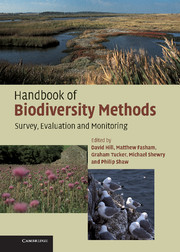Book contents
- Frontmatter
- Contents
- Preface
- Acknowledgements
- Part I Planning
- Part II Habitats
- Part III Species
- 9 Introduction to species assessment
- 10 General principles and methods for species
- 11 Fungi
- 12 Lichens
- 13 Bryophytes
- 14 Aquatic macrophytes and algae
- 15 Vascular plants
- 16 Dragonflies and damselflies
- 17 Butterflies
- 18 Moths
- 19 Other terrestrial invertebrates
- 20 Aquatic invertebrates
- 21 Fish
- 22 Amphibians
- 23 Reptiles
- 24 Birds
- 25 Bats
- 26 Other mammals
- Appendix 1 Monitoring and reporting obligations under international conservation agreements
- Appendix 2 Relationship between BAP Priority Habitat and Broad Habitat categories and Habitats Directive nomenclature
- Appendix 3 Annotated list of key references for plant identification
- Appendix 4 Determining appropriate quadrat size for vegetation sampling
- Appendix 5 The relocation of permanent plots
- Appendix 6 Equipment required for undertaking different types of survey
- Recommended sources of further information
- References
- Glossary
- Index
11 - Fungi
Published online by Cambridge University Press: 01 September 2010
- Frontmatter
- Contents
- Preface
- Acknowledgements
- Part I Planning
- Part II Habitats
- Part III Species
- 9 Introduction to species assessment
- 10 General principles and methods for species
- 11 Fungi
- 12 Lichens
- 13 Bryophytes
- 14 Aquatic macrophytes and algae
- 15 Vascular plants
- 16 Dragonflies and damselflies
- 17 Butterflies
- 18 Moths
- 19 Other terrestrial invertebrates
- 20 Aquatic invertebrates
- 21 Fish
- 22 Amphibians
- 23 Reptiles
- 24 Birds
- 25 Bats
- 26 Other mammals
- Appendix 1 Monitoring and reporting obligations under international conservation agreements
- Appendix 2 Relationship between BAP Priority Habitat and Broad Habitat categories and Habitats Directive nomenclature
- Appendix 3 Annotated list of key references for plant identification
- Appendix 4 Determining appropriate quadrat size for vegetation sampling
- Appendix 5 The relocation of permanent plots
- Appendix 6 Equipment required for undertaking different types of survey
- Recommended sources of further information
- References
- Glossary
- Index
Summary
The groups of fungi covered in this section are restricted to the macromycetes. This is not a precise taxonomic definition (it generally includes the basidiomycetes minus rusts, smuts and yeasts with some ascomycetes and myxomycetes), but it is convenient and commonly used (Watling, 1995). Although this grouping generally applies to the mushrooms and toadstools (correctly termed agarics), polypores and their relatives and jelly fungi, a few prominent ascomycetes such as the earth tongues, truffles and their allies are included. This grouping contains three different categories of fungi based on life strategy: biotrophs, which include basidiolichens and mycorrhizal species; saprotrophs, which include litter and wood rotters; and the necrotrophs or parasites. An informed biological approach should always be considered when dealing with members of each category. For example, a wood rotter may be restricted to a single tree trunk, whereas an ectomycorrhizal fungus may be associated with a widely spreading mycelial system that covers several square metres.
The survey and monitoring of fungi presents some difficulties that need to be taken into consideration when designing a monitoring strategy. Surveying for presence or absence of macromycetes depends upon the appearance of the fruiting body (sporome). The number of fruiting bodies is considered to reflect the health and spatial extent of a fungal colony, although there is little scientific evidence to support this. Sporome appearance is influenced by a number of environmental factors including temperature, amount and timing of rainfall, soil pH and nutrient status, and successional patterns of surrounding vegetation.
- Type
- Chapter
- Information
- Handbook of Biodiversity MethodsSurvey, Evaluation and Monitoring, pp. 271 - 278Publisher: Cambridge University PressPrint publication year: 2005



